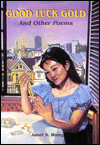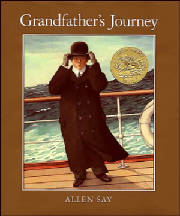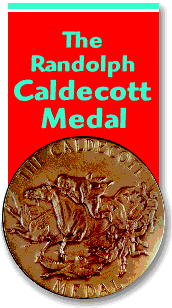|
|
 |
|
Wong, J. 1994. Good Luck Gold And Other Poems. New York: Margaret K. McElderry Books.
ISBN: 0-689-50617-1

Good Luck Gold And Other Poems is a collection of poems that reflect Janet Wong’s childhood experiences, growing
up in Los Angeles as an Asian-American child. There are numerous poetry forms found in this book; including rhymed poetry,
free verse, haiku, dialogue, and question and answer poems. Wong uses cultural markers that include foods in different poems
such as, "peking duck", "soy sauce chicken and squab in lettuce cups", "banana leaves", "roast duck", "crisp wings", and "din
sum stands". Wong uses some Asian words such as, "halmoni", "haraboji", and "imo". (She repeats most of the words with the
equivalent in English.) Wong includes poems that deal with negative stereotypes. "Waiting on the Railroad Café" (p8) is about their family not getting waited on because of their race. "Bombs Bursting in Air" (p17)
is about their family being at a game listening to the national anthem being sung by an Asian singer and men behind them making
racial comments. "Noise" (p19) is about kids calling her the name "Ching Chong".
Sandra S. Yamate writes in a multiethnic literature textbook, "‘positive’ stereotypes are just as damaging
as negative ones" (p99). Janet Wong uses the poem, "Math" on page 18, as an example of positive stereotypes growing up. Wong
does include universal experiences such as family death and birthdays. The cover is painted by James Hoston. It shows an Asian
American girl looking at her "good luck" jewelry with a backdrop of the city skyline through a window.
This is a great book for a read out loud to include Asian culture, prejudices, and universal situations that a child can
go through growing up.
Harris, V. (editor) (1997). Using Multiethnic Literature in the K-8 Classroom. Norwood, MA: Christopher Gordon.
ISBN:0926842609.
|
 |
|
Say, A. 1993. Grandfather's Journey. New York: Houghton Mifflin.
ISBN: 0-395-57035-2

Grandfather’s Journey is written and illustrated by Allen Say. This book is about Say’s grandfather
and his love of two different countries. The grandson later forms the same bond to the two countries. Say uses watercolors
to paint family portraits and landscapes that encompass pride, tradition, and honor. Each of the pictures are surrounded by
a thin black frame. In the first picture, Say paints a portrait of his grandfather in traditional Japanese dress, with accurate
eye shape, correct skin color, and dark hair. This same picture is used as the final picture of this book, but on a smaller
scale and a bigger frame making the reader think of the last picture as in the past, the first picture in the present. In
the middle of the book, Yep writes of black, white, yellow, and red men shaking hands with his grandfather. The pictures depict
all the races in a row with the differences of skin hue and eye shapes. Later in Grandfather’s Journey,
Yep writes about the grandfather’s daughter and beautifully captures the racial differences between the daughter and
her Caucasian doll in his painting. The Japanese daughter has black hair, correct eye shape, and darker skin, while the
American doll has white skin, round eyes, and blond hair. Pride and custom is shown in his grandfather when he is living in
California but goes back to his Japanese village to bring back his childhood sweetheart to marry.
Grandfather’s Journey is a fabulous picture book to share with young elementary students to share Japanese dress,
family importance, and that loving two countries is acceptable. Grandfather’s Journey is the winner of the
1994 Caldecott Medal for Say’s illustrations.
|
 |
|
Grandfather's Journey is the 1994 Winner of the Caldecott Medal.
| Click on the medal below to learn more! |

|
|
 |
|
|
 |
|
|
|
|
|
Yep, L. 1999. The Amah. New York: G.P. Putnam's Sons.
ISBN: 0-399-23040-8

The Amah is about a twelve year old girl named Amy, who finds
that finds her family responsibilities are interfering with her ballet practices because her mother had to take a job as a
nanny. The author, Laurence Yep, had a grandmother who was a Chinese Amah. Yep interviewed different Chinese Amahs, children
of Amahs, and children raised by Amahs to get an authentic feel for the family dynamics. The title of the book, Amah,
is a Chinese word for nanny or governess. Yep uses many other cultural markers in this book to make it an authentic piece
of literature for the Chinese culture. The characters talk about Chinese soap operas, martial arts movies, proverbs in Chinese,
and a Chinese game called "grasping many tens". Yep uses cultural specific foods such as "pressed duck in a coating of taro",
"shark’s fin soup", "loquats", "dragon tear tea", and "chopsticks". Amy’s mother is from Hong Kong and she also
frequently visits Chinatown with a "group grandma" from Hong Kong that has "lily feet". "Lily feet" are from an old custom
in China where mothers wrap their daughters’ feet to keep them small and more delicate in appearance.
The characters in The Amah use many references to the country of China.
While mom is talking to Amy, she says "In China, fat means prosperity" (p.32). Amy hastily responds to her mother later in
the book, "That was in China. We’re in America now" (p.39). Mom states in the book, "Things are so clear-cut in China.
Here it’s all so confusing" (p.64). The shared grandmother says to Amy, "Chinese mothers show their love in deeds, not
in words" (p.97).
The cover by Stephen Johnson depicts a picture of the protagonist, Amy. Johnson
includes dark hair, slanted eyes, and skin color that is consistent with Chinese culture.
This book shows to be an authentic example of a Chinese family living in California
by use of Yep’s genuine cultural markers.
READ!READ!READ!
Book covers on this web site are from Barnes and Noble's website at www.bn.com.
|
|
|
 |

